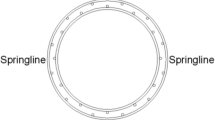Abstract
Corrosion of steel rebar is the most important durability problem of reinforced concrete. The aim of this research was to investigate the corrosion behavior of steel rebar in simulated pore solutions and gangue-blended cement mortar. The simulated pore solutions were based on the pore solution composition of gangue-blended cement. The pH and Cl− concentration of simulated pore solutions had significant effects on corrosion potential. However, an increase in pH reduced the influence of Cl− concentration on corrosion potential. The corrosion behavior of steel rebar in gangue-blended cement is different from that in simulated solutions. The gangue cementitious mortar surrounding steel rebar provides stable passivity environments for steel, leading to a decrease in ion diffusion coefficients. Alternating current impedance (ACI) analysis results indicated that the indicator R c for concrete resistivity is higher for gangue mortar than for ordinary Portland cement (OPC), which improves its corrosion potential. The results from energy dispersive X-ray analysis (EDX) showed more aluminates and silicates at the rebar interface for gangue-blended cement. These aluminates improve the chloride binding capacity of hydrates in mortar, and increase the corrosion protection of steel rebar.
Similar content being viewed by others
References
Batis, G., Pantazopoulou, P., 2005. The effect of metakaolin on the corrosion behavior of cement mortars. Cement & Concrete Composites, 27(1):125–130. [doi:10.1016/j.cemconcomp.2004.02.041]
Berkely, K.G.C., Pathmanaban, S., 1990. Cathodic Protection of Reinforcement Steel in Concrete. Butterworths & Co. Ltd., London.
Chen, D., Mahadevan, S., 2008. Chloride-induced reinforcement corrosion and concrete cracking simulation. Cement & Concrete Composites, 30(3):227–238.
Fajardo, G., Valdez, P., Pacheco, J., 2009. Corrosion of steel rebar embedded in natural pozzolan based mortars exposed to chlorides. Construction and Building Materials, 23(2):768–774. [doi:10.1016/j.conbuildmat.2008.02.023]
Hausmann, D.A., 1967. Steel corrosion in concrete: how does it occur. Materials Protection, 6(11):19–23.
Higgins, C., Farrow III, W.C., 2006. Tests of reinforced concrete beams with corrosion damaged stirrups. ACI Structural Journal, 1:133–141.
Hussain, S.E., Rasheeduzzafar, S., Al-Musallam, A. Al-Gahtani, A.S., 1995. Factors affecting threshold chloride for reinforcement corrosion in concrete. Cement and Concrete Research, 25(7):1543–1555.
Hussain, S.E., AlGahtani, A.S., 1996. Chloride threshold for corrosion of reinforcement in concrete. ACI Materials Journal, 94(6):534–538.
Jin, W.L., Zhao, Y.X., 2001. Effect of corrosion on bond behavior and bending strength of reinforcement concrete beams. Journal of Zhejiang University-SCIENCE, 2(3):298–308.
Li, D.X., Song, X.Y., Gong, X.X., 2006. Research on cementitious behavior and mechanism of pozzolanic cement with coal gangue. Cement and Concrete Research, 36(9):1752–1759. [doi:10.1016/j.cemconres.2004.11.004]
Li, H.J., Sun, H.H., Xiao, X.J., 2006. Mechanical properties of gangue-containing aluminosilicate based cementitious materials. Journal of University of Science and Technology Beijing, 13(2):183–189.
Mohammed, T.U., Hamada, H., 2006a. Corrosion of horizontal bars in concrete and method to delay early corrosion. ACI Materials Journal, 103(5):303–311.
Mohammed, T.U., Hamada, H., 2006b. Corrosion of steel bars in concrete with various steel surface conditions. ACI Materials Journal, 103(4):233–242.
Morris, W., Vico, A., Vázquez, M., 2004. Chloride induced corrosion of reinforcing steel evaluated by concrete resistivity measurements. Electrochimica Acta, 49(25):4447–4453. [doi:10.1016/j.electacta.2004.05.001]
National Economic and Trade Commission, 1999. Technology Policy Points of Gangue Comprehensive Utilization Technology Policy Points. Chinese Ministry of Science and Technology.
Polder, R.B., 2002. Characterization of chloride transport and reinforcement corrosion in concrete under cyclic wetting and drying by electrical resistivity. Cement & Concrete Composites, 24(5):427–435. [doi:10.1016/S0958-9465(01)00074-9]
Querol, X., Izquierdo, M., Monfort, E., 2008. Environmental characterization of burnt coal gangue banks at Yangquan, Shanxi Province, China. International Journal of Coal Geology, 75(2):93–104. [doi:10.1016/j.coal.2008.04.003]
Rasheeduzzafar, 1992. Influence of cement composition on concrete durability. ACI Materials Journal, 89(6):574–586.
Radhakrishna, G., Pillai, D., Trejo, 2005. Surface condition effects on critical chloride threshold of steel reinforcement. ACI Materials Journal, 102(2):103–109.
Shi, M.L., Chen, Z.Y., 1998. Study of AC impedance on the porous structure of hardened cement paste. Journal of Building Materials, 1(1):30–35.
Shi, M.L., Chen, Z.Y., Sun, J., Hu, Y., 2000. Electrochemical research on the hydration process of Cement(II)—ACIS of hardened cement paste under DC polarization. Journal of Building Materials, 3(3):218–222.
Sujjavanich, S., Sida, V., 2005. Chloride permeability and corrosion risk of high-volume fly ash concrete with mid-range water reducer. ACI Materials Journal, 102(3):177–182.
Thompson, J.B., 1947. Role of aluminum in the rock-making silicates. Bulletin of the Geological Society of America, 58:12–32.
Townsend, H.E., Cleary, H.J., Allegra, L., 1981. Breakdown of oxide films in steel exposure to chloride solutions. NACE Corrosion, 37:384–391.
Virmani, Y.P., 2002. Corrosion Costs and Preventive Strategies in the United States. Federal Highway Administration Report No. FHWA-RD-01-156.
Xu, Z.Z., 1994. Development in electrochemistry of cement and concrete science—AC impedance spectroscopy theory. Journal of the Chinese Ceramic Society, 22(2):173–180.
Zhang, Y.L., Li, Q.L., 2006. Electrochemical study on semi-conductive properties of the passive film on rebar in concrete. Journal of Zhejiang University-SCIENCE A, 7(8):1447–1452. [doi:10.1631/jzus.2006.A1447]
Author information
Authors and Affiliations
Corresponding author
Additional information
Project supported by the National Natural Science Foundation of China (No. 50674062), the National Science & Technology Pillar Program (No. 2006BAC21B03), and the Beijing Science and Technology Plan Projects (No. D07040300690000), China
Rights and permissions
About this article
Cite this article
Zhang, Jx., Sun, Hh., Sun, Ym. et al. Corrosion behavior of steel rebar in coal gangue-based mortars. J. Zhejiang Univ. Sci. A 11, 382–388 (2010). https://doi.org/10.1631/jzus.A0900443
Received:
Accepted:
Published:
Issue Date:
DOI: https://doi.org/10.1631/jzus.A0900443




